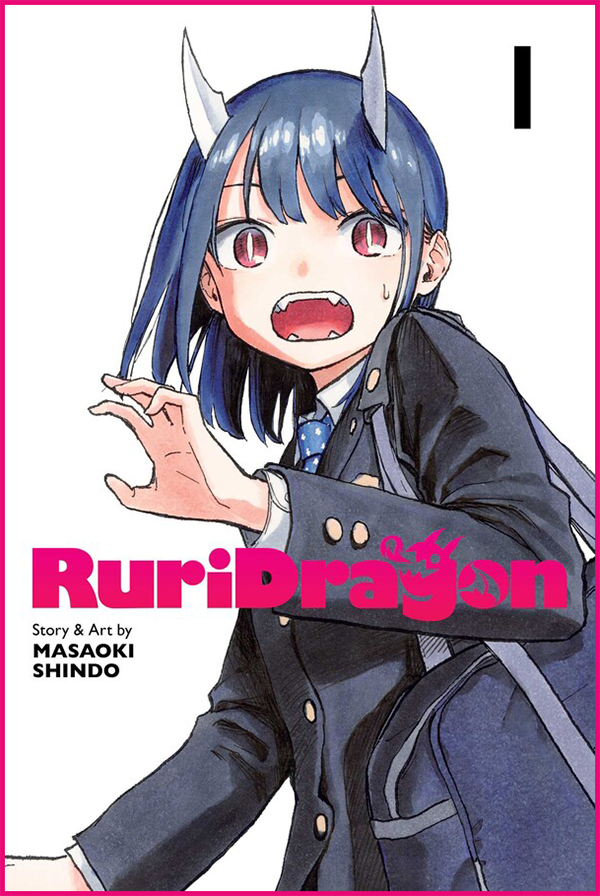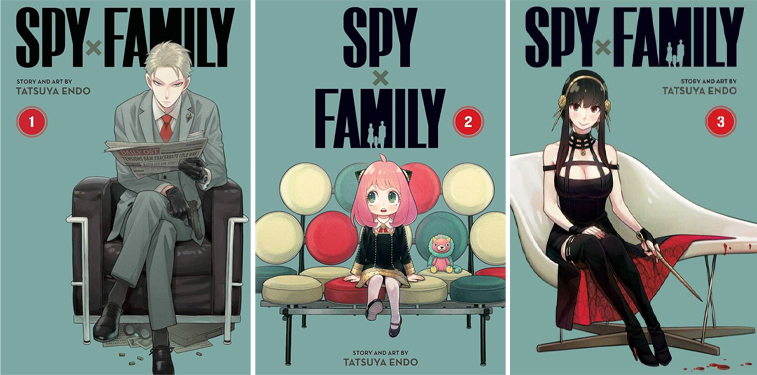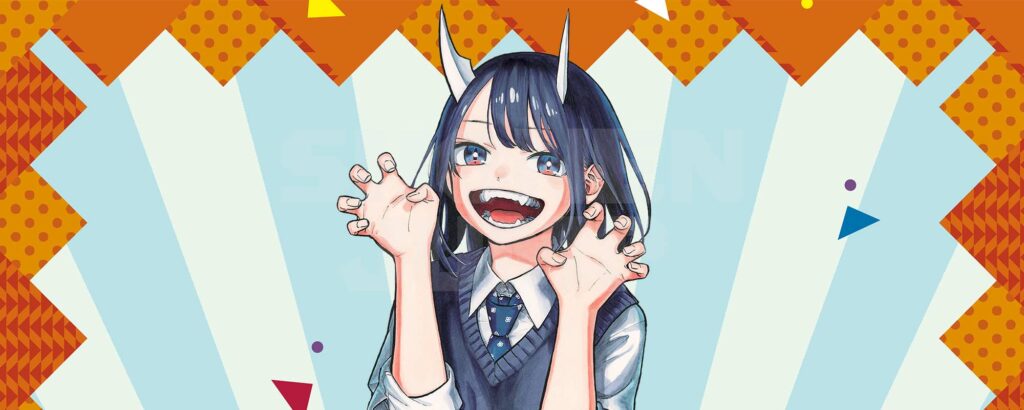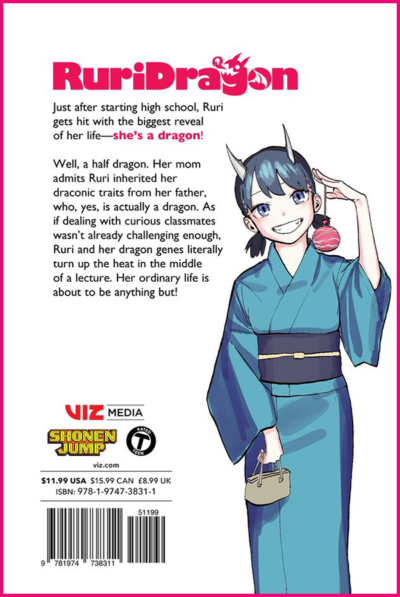Enter the Half-Dragon
High schooler Ruri Aoki wakes up one day to find she grew a pair of horns overnight. The most surprising thing is how unsurprised Ruri’s mother seems, and Ruri soon finds out why: Ruri’s biological father is a dragon!
Ruri tries to go about her day as normal, but that flies out the window when flames start flying out of her mouth. It sounds like this would be the start of a heroic adventure, but Ruri’s human throat doesn’t appreciate being burned to a crisp.
Learning that her human body will have to adjust to each new dragon trait as they appear, Ruri tries to live a normal life while suffering the growing pains of half-dragon puberty.

RuriDragon
Writing and Art by Masaoki Shindo
Published by Shueisha, Viz Media
Serialized in Weekly Shonen Jump, Shonen Jump+
Running since June 13, 2022
Appropriate for ages 13 and up
Genres include coming-of-age, fantasy and slice-of-life
Quick Review: RuriDragon is a slice-of-life, coming-of-age manga with a chill supporting cast and a protagonist with a subtle character arc in which she goes from a detached loner to the talk of the town. Like many slice-of-life stories, RuriDragon is more concerned with vibes than “plot” in the traditional sense, with the first volume establishing Ruri’s support network of friends and family. RuriDragon presents a kind world in which people support each other.
While the first volume of RuriDragon is an excellent feel-good story on the surface, you can find greater depth to this story if you’re willing to read between the lines. Regardless of how you engage with it, this manga is totally worth your time. The art does what the slice-of-life genre does best: show the beauty in the mundane. And if you’re already following the serialized release, this collected volume provides fun new illustrations from the author!
Jumping Into a New Era of Manga
I’ve discussed Weekly Shonen Jump magazine and its associated brands quite a few times on this blog. Since Shueisha is the biggest publishing company in Japan and the Jump line of magazines is their biggest breadwinner, it’s an unavoidable topic if you want to talk about manga in a cultural or industrial context. And if you’ve followed my blog posts so far, you know I love me some context.
Over the course of my lifetime, the Jump line of magazines, both physical and digital, have been associated with action comics first and foremost. In the 90s, their biggest titles were the likes of Dragon Ball Z, Rurouni Kenshin and JoJo’s Bizarre Adventure. The new millennium continued this trend with Naruto, One Piece and Bleach—a trio of titles many anime fans refer to as The Big Three. Then My Hero Academia and Demon Slayer: Kimetsu no Yaiba dominated the 2010s, the former topping anime of the decade lists while the latter’s animated film adaptation smashed Japanese box office records.

Now we’re halfway through the Not-So-Roaring 20s, and there’s been a noticeable shift in which Jump titles have received acclaim from critics and audiences and a matching shift in the magazine line’s output. While One Piece still sits comfortably on its throne as the most popular Jump title among Japanese readers, the action-comedy Spy x Family is a smash hit with audiences across the globe, while the coming-of-age dramedy Akane-banashi has been highly praised by every anime news outlet and several library organizations. Then there’s the equally acclaimed dark fantasy Chainsaw Man and the audience darling Dandadan, which is a bizarre mishmash of action, romantic comedy and supernatural thriller.
RuriDragon not only continues this shift into a more eclectic mix of genres topping the charts but takes things a step further. Most of the titles I listed are still partly action manga, and the sole holdout, Akane-banashi, draws heavily from sports manga—another Jump staple. RuriDragon, however, almost feels defiant in how it avoids shifting into an action-adventure fantasy.
It’s certainly not unheard of for Jump titles to shift from one genre into a more formulaic battle manga. Yu-Gi-Oh! infamously started out with a lot of horror elements in its first seven volumes before settling into the children’s card game anime we all know and love. Meanwhile, Yu Yu Hakusho had Yusuke Urameshi going on ghostly adventures before he became a professional demon-puncher. So I expected the same of RuriDragon. But with 27 serialized chapters as of this writing, that hasn’t happened. It really is just a slice-of-life story where the lead happens to be a half-dragon.
It’s a surprise in the context of the typical Jump line-up, but it does make sense with regard to current trends in manga, anime and light novels. Portal fantasy, known in Japan as isekai, is currently awash with stories that throw the protagonist into a fantasy world only for said protagonist to forgo adventure in favor of cottage-core coziness or other forms of domestic bliss. You’ll often recognize these books by their absurdly long titles, such as I’ve Been Killing Slimes For 300 Years And Maxed Out My Level or My Next Life as a Villainess: All Routes Lead to Doom.
Romantasy novels have formed a similar trend in the US. Titles like Legends & Lattes and Can’t Spell Treason Without Tea present burnt-out adventurers giving up a life of D&D-style quests in favor of running a café.
So, given these concurrent trends, audiences on both sides of the planet are primed for a book like RuriDragon. But that also means it can be difficult to stand out among the crowd. So let’s look at what mangaka Masaoki Shindo brings to the table.

Unconditional Support
While RuriDragon isn’t totally tensionless, this initial volume is definitely a feel-good story. While Ruri is understandably frustrated by how her mother failed to give her a heads-up about the whole dragon traits thing, it’s quite clear that Umi, the aforementioned mother, avoided the matter for understandable reasons. And once the matter becomes unavoidable, Umi is quick to put her all into learning everything she can and providing firm support for her daughter.
Ruri’s friends and classmates are similarly supportive. Yoshioka, the boy whose hair she accidentally sets on fire when her fire breath awakens, brushes off the issue and shows far more concern for Ruri’s condition after she injured herself in the same incident. Meanwhile, resident extrovert Kashiro, a girl from Ruri’s class who also stands out for her pink and purple highlights, adopts the comparatively introverted Ruri and brings the latter into her friend group.
The unconditional support Ruri receives is deeply touching. It’s the sort of thing everyone who doesn’t fit the mold should receive. While Ruri’s half-dragon status doesn’t appear to be an explicit allegory for any one thing, it’s really easy to apply her unique struggles to all sorts of things. When Ruri marvels at the kindness of the people around her, at how willing they are to accept and love her despite being what some would describe as a “monster,” it reminds me of the kindness and acceptance other people have shown me.
Unspoken Ennui
 So the supporting cast is delightful, but what about Ruri herself? At a glance, she seems rather plain. Even though I’m up to speed with the latest chapters – the manga is still being serialized on digital platforms at this time of writing – I couldn’t tell you a lot about her. As such, it would be easy to dismiss her as a boring and bland protagonist. But as I reread this first volume, I noticed something: she doesn’t smile all that much. RuriDragon premiered in Weekly Shonen Jump, which tends to feature pretty jovial protagonists. Granted Ruri is going through a lot with the transformation, but she doesn’t seem all that upset with the change, either. If anything, she comes across as bored and listless.
So the supporting cast is delightful, but what about Ruri herself? At a glance, she seems rather plain. Even though I’m up to speed with the latest chapters – the manga is still being serialized on digital platforms at this time of writing – I couldn’t tell you a lot about her. As such, it would be easy to dismiss her as a boring and bland protagonist. But as I reread this first volume, I noticed something: she doesn’t smile all that much. RuriDragon premiered in Weekly Shonen Jump, which tends to feature pretty jovial protagonists. Granted Ruri is going through a lot with the transformation, but she doesn’t seem all that upset with the change, either. If anything, she comes across as bored and listless.
The series doesn’t dwell on Ruri’s family situation other than to show that she has a loving mother who’s doing her best. Ruri never expresses any outward grief over having never known her father, and she doesn’t even seem particularly interested in meeting him even though her mother knows where to find him. Still, growing up with only a single parent who has to work full-time to keep food on the table is rough, no matter how wonderful that parent is. On top of that, Ruri apparently only had one friend before growing a pair of horns. As a result, I can’t help but read her seemingly lackluster personality as a sign of detachment and ennui.
It’s subtle, but I believe the story is about Ruri shifting out of that ennui and learning that the world can be a loving place. She’s taken aback by her classmates’ kindness and by how much her mother cares about her. And that kindness clearly has an impact on her. It’s a gradual character arc, but I’m highly excited to see where it goes from here.
The Beauty of the Mundane
Despite the fantasy elements, this is a grounded story about growing up differently in high school. Therefore, as paradoxical as it might sound, it’s fitting that the character designs of RuriDragon stand out for how subdued they are compared to the manga’s contemporaries. While Spy x Family stars the pink-haired Anya and Frieren: Beyond Journey’s End prominently features the purple-haired Fern, the color pages and character commentary of RuriDragon suggest that the characters don’t feature such creative liberties with natural hair colors. Kashiro, the one character who has unusually colored hair, is specifically stated to have dyed it as such.
The lowkey character designs can blend together a little bit, but this appears to be a deliberate creative choice. These same characters are usually introduced without any fanfare. Ruri confesses to being terrible with names, and, as I said earlier, she comes across as socially detached from those around her. So the fact that it takes a little effort on the reader’s part to remember who’s who puts you in Ruri’s position.
Though the character designs purposefully lack flare, the art is as cute and expressive as you would want a manga to be. The way Shindo-sensei draws Ruri’s eyes is particularly expressive, managing to make them shimmer and shine in a way that almost makes me forget that what I’m looking at is on plain paper. The more energetic characters like Umi and Kashiro are also highly expressive, and Ruri’s smile is adorable once she starts to cheer up.
Ruri’s dragon powers are also well rendered. Her flames have an almost cloud-like appearance that implies a certain grace, while the way they take up space on the page suggests their power. Ultimately, though, this series does what the slice-of-life genre does best: show the beauty of mundane life. Simple moments like Ruri playing video games with her mom or getting drinks at Starbucks are the stars of the show here.
Incidentally, yes, the manga actually does use real brand names, which gave me a bit of whiplash since YA manga near-universally use parody names.
Back on topic, the title pages usually show off Ruri and her friends doing something adorable. As is common with manga, the collected volume has additional illustrations by the author. So, even if you’re following the serialized release, make sure you don’t skip this first volume!
Final Thoughts
The first volume of RuriDragon is a great starting point for the series, setting up a delightful supporting cast while showing the first steps of Ruri’s journey. Shindo-sensei appears to be setting the stage for a slow-burn coming-of-age story, and every new chapter has me excited to see what sort of person Ruri grows into. Give the first volume a look and see if you feel the same way!
